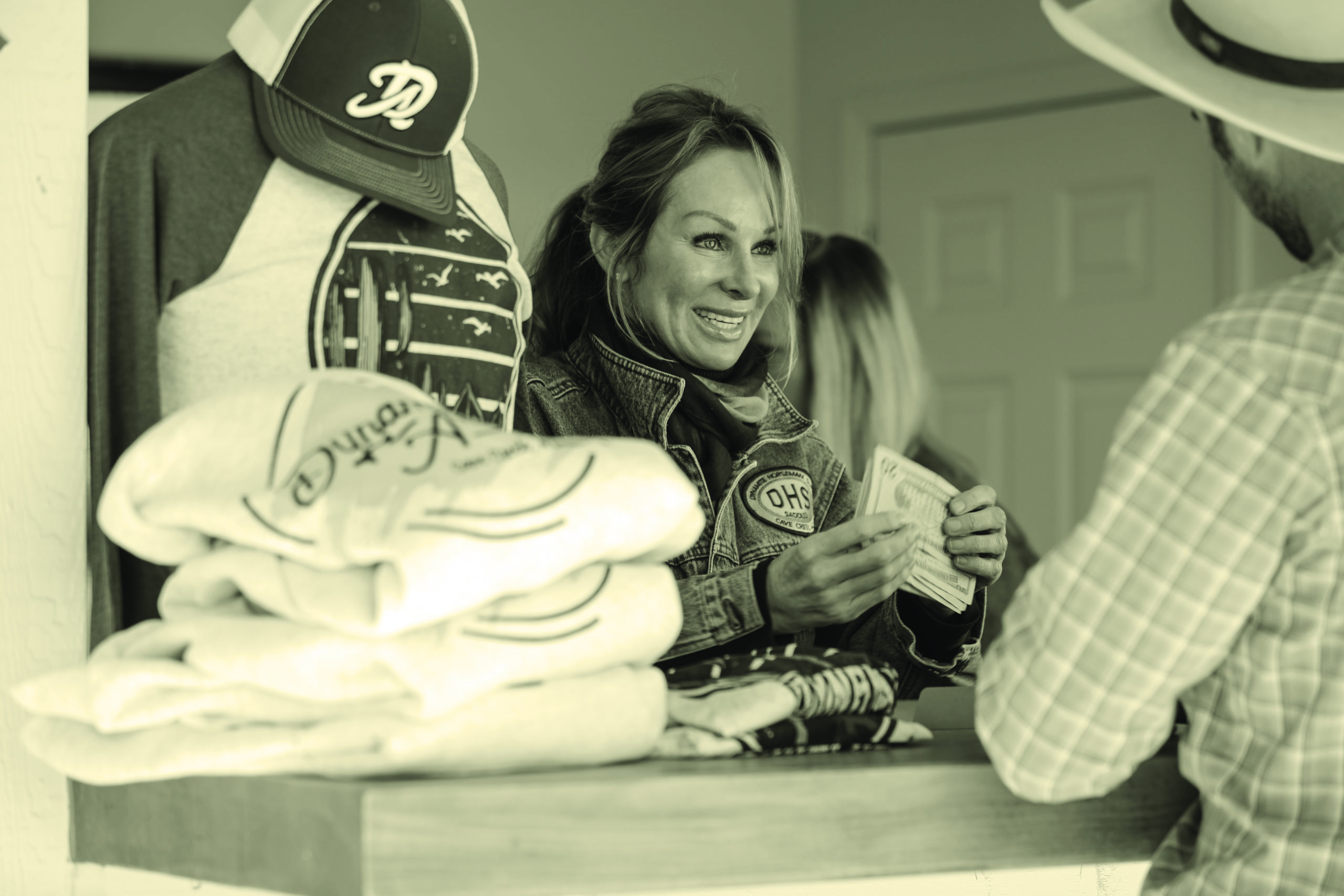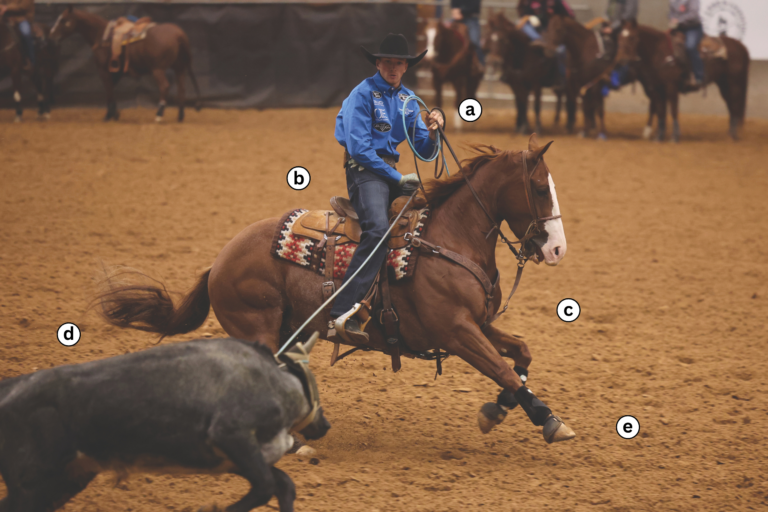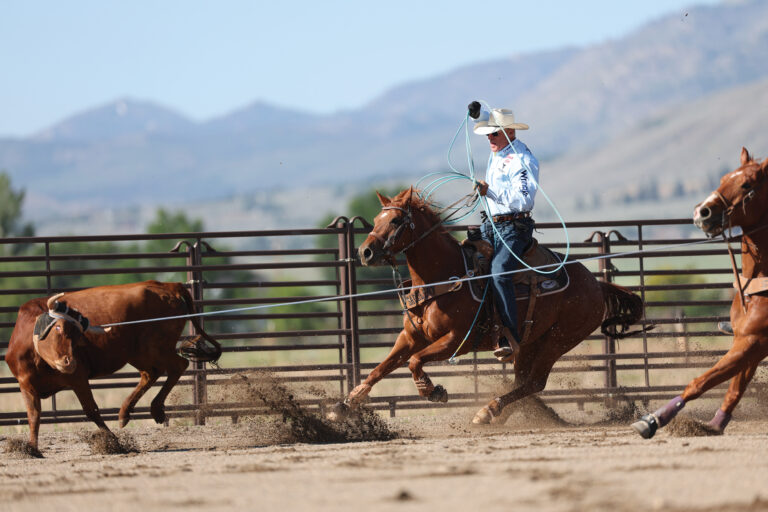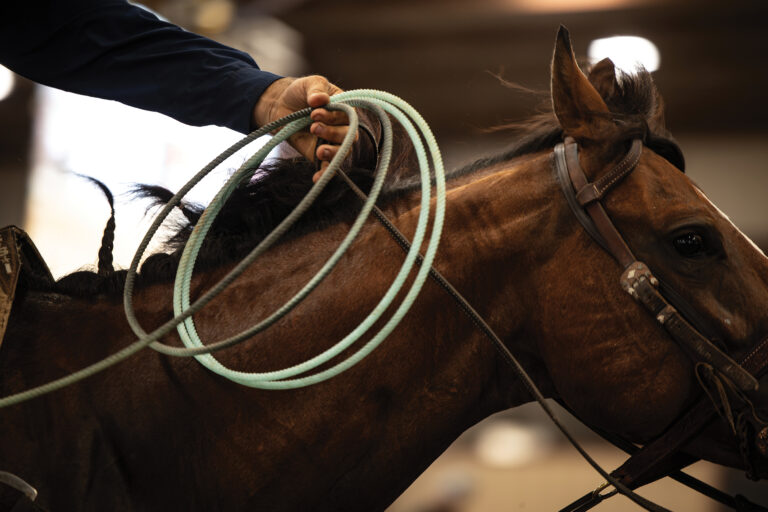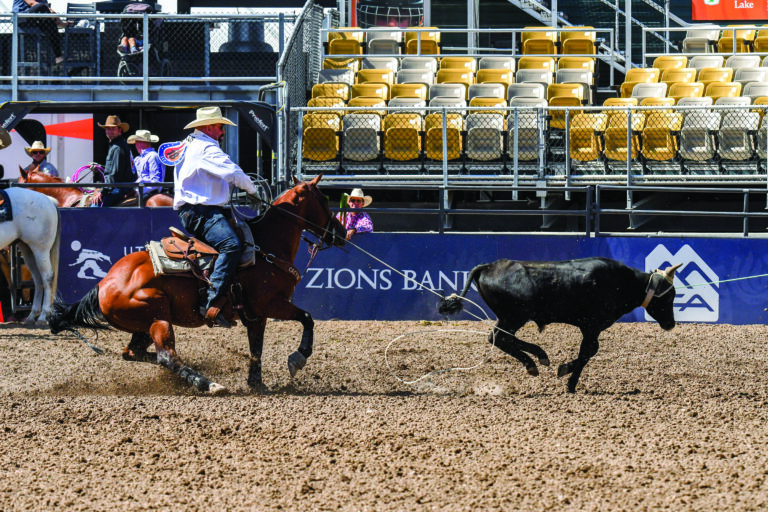Secretaries aren’t just the unsung heroes of our sport, they’re usually unseen, too. Behind a wall in a stuffy, small structure, sometimes just a single person is feverishly making the team roping event seem seamless. We talked to some who do it week in and week out about the gig itself and the latest software that’s making their job easier.
Sixteen-time NFR steer wrestler Rod Lyman and his wife, Stefani, produce ropings all winter in Arizona and, last summer, hosted a little Friday night series in Dillon, Montana. Stefani learned on the fly to announce and, in the past few years, became a secretary, too.
“It’s not a hard job until something goes wrong,” Stefani said. “Until you’re announcing and your computer freezes for 30 seconds, you haven’t really become experienced.”
The closeness that announcers, timers and secretaries develop is barely explainable—they’re like veterans of a war zone. The lone announcer usually times, too. He or she rattles off three teams at a time, over and over, while timing each run, writing down each time and entering each time into the computer, while constantly watching the flagger, obeying radio orders from the producer and rolling various teams down to pick up later. The secretary is entering teams, looking up classifications, fixing bad or illegible entries, moving teams as needed, printing timer sheets, figuring payouts, filling envelopes and the list goes on.
Three years ago, Jamie Baker had just earned a bachelor’s in business and was hating her new job at a bank. She jumped at the chance to quit and become secretary at Dynamite Arena in Cave Creek, Arizona. She hasn’t regretted a day of that decision.
“The first couple of months were really stressful,” Baker admitted. “I’d just graduated, and I’d never had an entire business depend on me before. But now it’s just second nature.”
She came onto the scene about the same time as the industry’s latest event management software. Now called Global Event Management Software (GEMS), the program is flexible enough to be used for everything from a truck roping with 1,000 teams to a small draw pot or round-robin event.
“I had used the old program, Central Entry, for two weeks, and you needed scratch paper for every change you had to make,” Baker said. “Now you can just hit one button for some of these changes. Secretaries who have used Roping Assistant Pro said GEMS combines the best features of both it and Central Entry. You can throw brand new announcers in the roping that have never used it, and within 10 or 20 teams they’ve got it down.”
•••••
Faster and faster
It’s amazing how technology and innovation have improved the “clunky” old programs, according to Ferron Lucero of Stephenville, Texas. A long-favored announcer for the USTRC and WSTR, he’s now their manager of customer service and digital integration.
According to Lucero, what sets GEMS apart from the rest is that it comes with the Global Handicaps database already installed, which means ropers are more likely to enter with an accurate classification at the roping. Secretaries are able to identify if a roper is current with an association through the use of GEMS, and the event reports help to identify and resolve problems before there is an issue.
“People want to go rope where they feel it’s fair,” Lucero said. “They want to know they have a chance. It’s just good to have integrity in the system.”
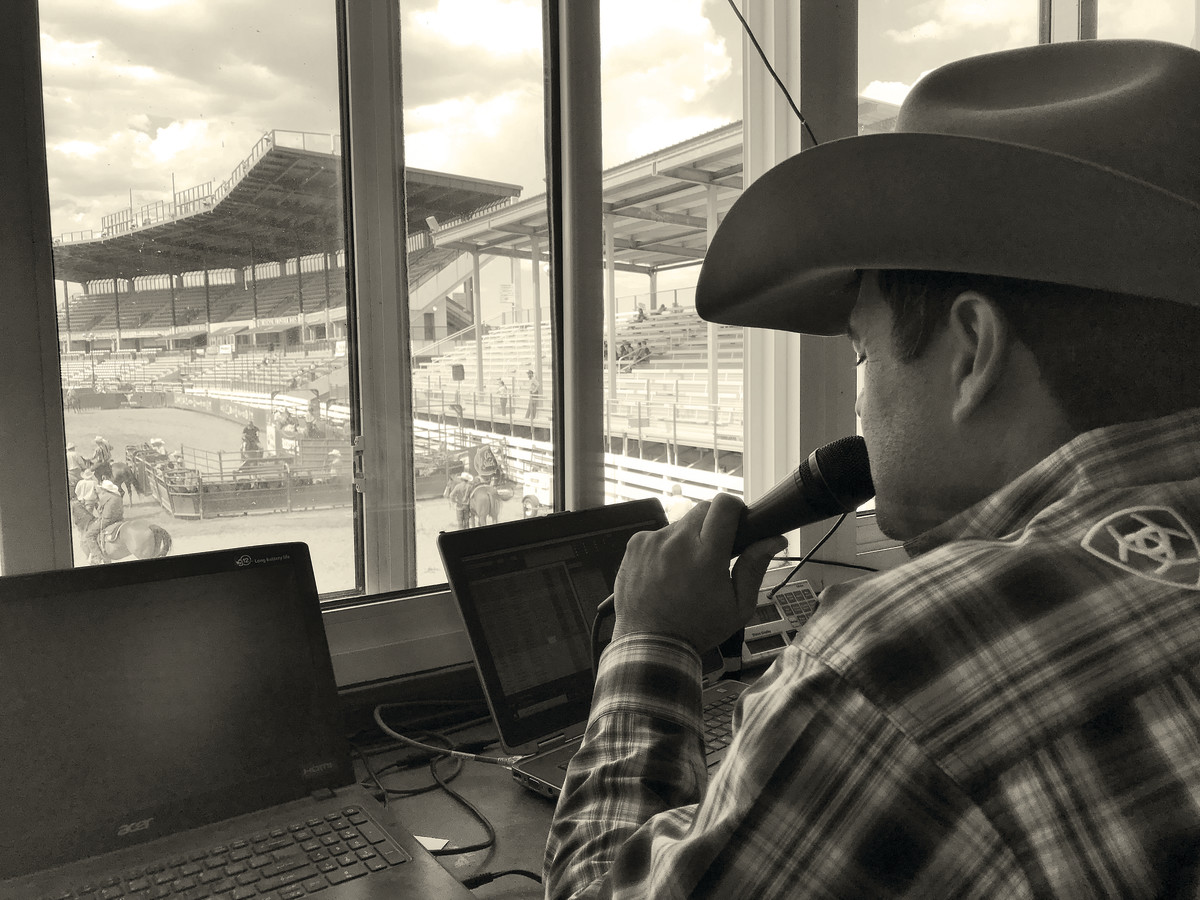
With an up-to-date database, producers and secretaries have the peace of mind that contestants are competing with the most current handicap.
After all, Global Handicaps has been 30 years in the making with a top-notch crew of IT staff implementing all the changes along the way. And it works both ways because GEMS provides Global Handicaps more specific data to accurately assess a roper’s ability. Finally, timers can mark in the computer which partner missed, legged up or broke out.
Based on the number of events that use GEMS, it is the preferred industry standard.
“It is used by major associations and qualifiers like WSTR, USTRC, NTR, NTRL/JX2, the BFI and more, but it was designed for everybody—not just the big associations. We have small benefit events as well as rodeos using the system,” Lucero said. “You can operate every facet of your roping with this software supported by a database of more than 120,000 ropers.”
Now, secretaries can personalize how they want to enter teams and have more options for running reports after the roping. Announcers can see more data on-screen, such as ropers’ hometowns, which makes for a better show. The system even generates catch percentages, alleviating anyone from having to do that math.
Kelsi Bramwell not only works events but facilitates the set-up of GEMS events, trains users and is on-call for troubleshooting. For 12 years, she has been behind the scenes and has progressed through all of the different systems.
“The evolution and enhancements with this new software have brought many more events/secretaries into the system who all say it makes their jobs so much easier,” Bramwell said. “The secretaries who have been in the business for decades express their appreciation that we seek their feedback and continually work to automate the tasks necessary to run a good event, reducing workload and errors. The IT team at Global Handicaps continues to enhance this product. It’s exciting to be part of these developments.”
Secretaries always have to make changes to team numbers while the roping is happening. If someone drew out in the old system, it was necessary to thumb through hundreds of entry cards to find replacements who hadn’t exceeded the maximum entries and had the same handicap. Now, the system generates a list with one click, which is a far cry from using the walkie-talkie to alert the busy announcer of the changes.
“Now, the system automatically makes those changes on the announcer’s screen and tells him or her with color-coded updates,” Baker added. “The announcer doesn’t have to scroll all the way back to the original team number.”
•••••
No IT majors needed
The way GEMS links to multiple computers means easier communication. And communication, according to Joyce Sewell, is the key to running a great roping.
“The more information we have, the faster the process will work,” said Sewell, who has run the office at major ropings from Oregon to Arizona since the 1990s. “The GEMS software is tied so well between the timer and secretary. With Central Entry, we had two separate modules for each.”
Florida’s Staci Sanders, too, said CE had a penchant for making a fool out of a good secretary. Sanders, a longtime secretary for JX2 Productions, also loves the ease with which she can find partners for a late entry now with GEMS. And it offers auditing on whether a particular team was drawn or picked and paid or not. Plus, it provides the number of extra runs, which helps the math.
“It has cut down on a lot of time-consuming tasks and lessened confusion,” Sewell said. “My favorite part is probably having everyone’s correct, up-to-date classification number, with no tweaking necessary. Also, moving teams around and texting out team numbers is just slicker.”
And who doesn’t love their numbers texted? It beats a long walk to a post-board where people have already carved up the draw list. Plus, at the end of the roping, the system immediately gives announcers placings in the Incentive or point standings.
“In Rapid City, I announced a truck roping with 938 teams and, 10 minutes after the last flag dropped, we knew who won the truck,” Lucero said. “Figuring the points used to take much longer.”
Another bonus is that GEMS can be linked directly to video boards or live streams, which is how the leaderboard screens are updated during the Ariat WSTR Finale in Las Vegas and USTRC National Finals. And, if the secretary is online, a linked program called TimeTracker gives anyone access to the timer sheet on a smartphone in real time. Anyone who wants to follow the event can log in as the roping proceeds to know which team is up and who made the short round, plus see instant results. If you’re not up for 343 teams, for instance, you can leave the fairgrounds without worrying. From home, parents, grandparents and anyone interested can track their favorite roper, too.
“Anybody can log in and basically see what the announcer sees: What team they’re on, how fast they were, what they are on three head and who’s making the short go,” Baker said. “And ropers love it because they know how many callbacks they might have and exactly how far down they’ll rope in the short go.”
•••••
Running the roping
It’s a lot of pressure, entering hundreds of teams correctly and being responsible for tens of thousands of dollars. But most secretaries say it’s the team ropers who draw them to the job.
Vicky Mounyo, a 30-year veteran (and a team roping producer in her own right), also runs the office for Shelley Productions and California Shootouts.
“I love the business; the roping community is like a family,” Mounyo said. “It’s my job to make sure I do my part on the front and back ends to make sure the ropers have ease in entering, competing and getting paid when they win. The production is smooth and the ropers are assured it will be run professionally.”
Linking multiple computers, especially when two arenas are used at an old tech-challenged fairground, used to mean someone needed a PhD in information technology, knowledge of secret digital folders and even a little bit of magic.
But technology has improved. Signal towers can be perched at each arena and plugged into a wireless router, then hard-wired to computers. Secretaries don’t start out as computer nerds. They put up with it because they like team ropers.
“It’s the people,” Sewell said. “They’re my friends. And the job is not just taking entries, but hopefully making it a pleasurable experience for customers, because we’re there to meet their needs.”
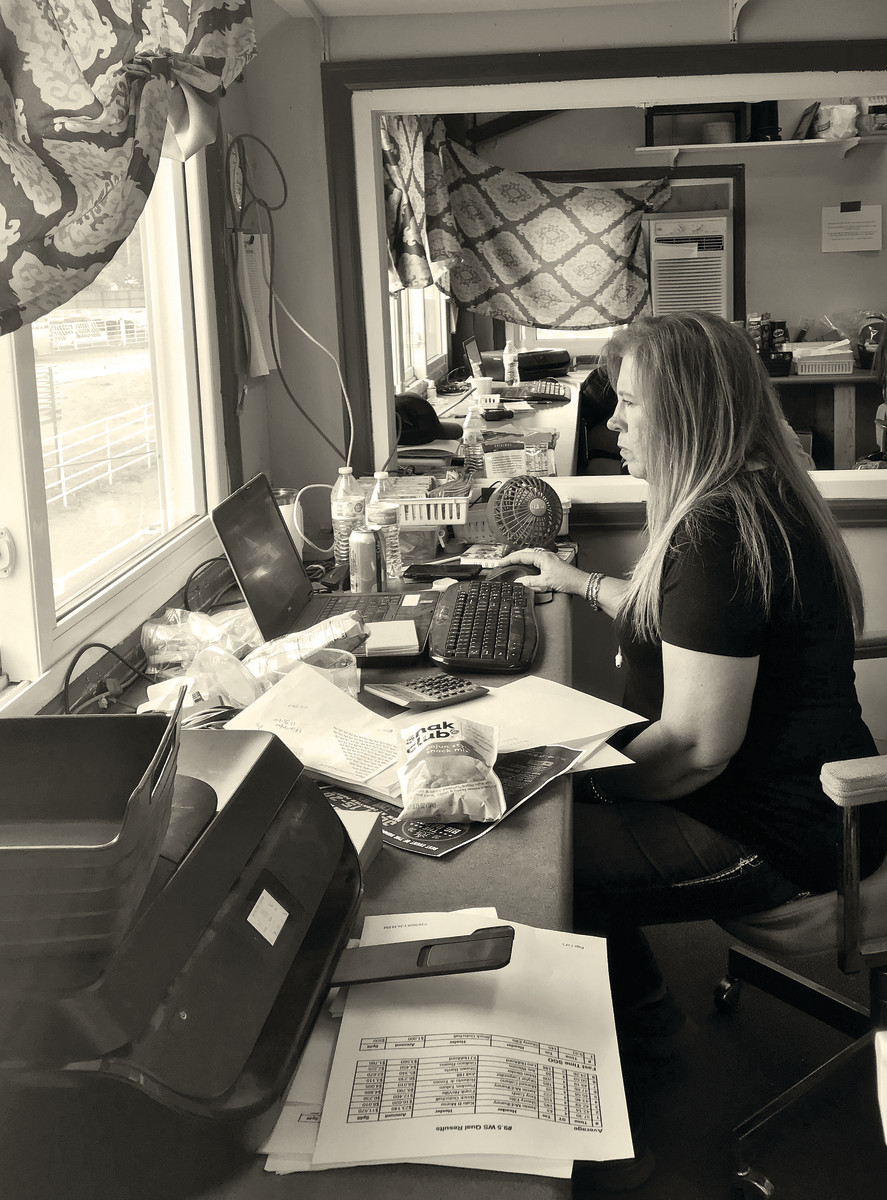
Sanders loves all the ropers she’s met and said if her car breaks down virtually anywhere in the country, a team roper she helped in the office is likely to come to her aid.
The best secretaries are like chefs who can’t give you the recipe because it’s in their head. Still, the overall key to a good roping is communication between the roper, secretary, announcer, flagger and entire staff.
“Pre-event preparation is key, so the staff knows what the producer expects,” Sewell said. “A good produced event means the entire production crew is on the same page about start times and things like whether you’re going to water and drag the ground before or after the short round.”
John Johnson of NTRL/JX2 Productions had that kind of meeting before he pulled off one of the most lucrative, fastest-moving ropings in recent memory. Prior to his 14 Annual Big Daddy in July—at Cheyenne’s Frontier Park for the first time—he counted heads. His staff numbered 55. That’s what it took to pull off the enormous six-day event, including five office staff members, plus a pair of announcers and a pair of timers.
Stuffed upstairs in the venue’s famed Chute No. 9—which typically hosts VIPs watching the rodeo—was the secretary, Pam Blevins, and her staff of four. Yes, it took GEMS and an experienced secretary staff to process 2,900 teams over six days and pay out more than $900,000.
The remarkable part? Even with 19 collective ropings, the action wrapped up by mid-afternoon nearly every day. Software notwithstanding, it takes an excellent crew of humans to do that.




